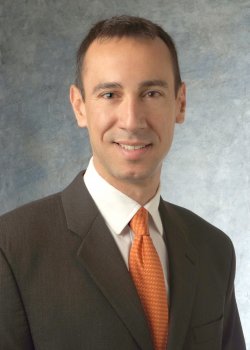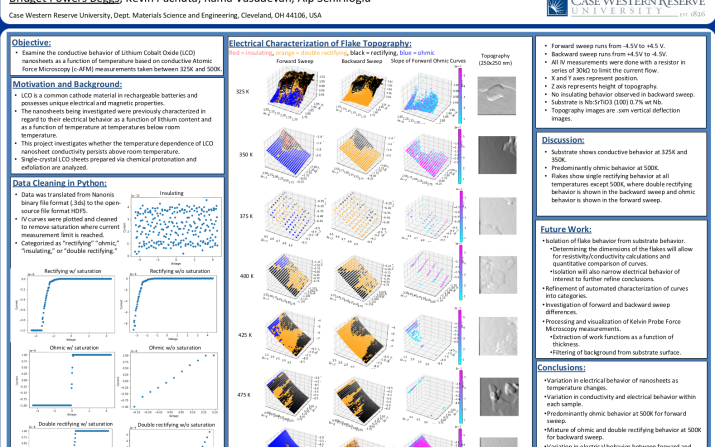
Students present at EMA 2022, Powers Beggs wins award

Case Western Reserve University’s Department of Materials Science and Engineering had a strong showing at American Ceramic Society’s annual Electronic Materials and Applications conference. Senior Bridget Powers Beggs won third place in the student poster competition and several other students and recent graduates gave oral and poster presentations.
Bridget Powers Beggs’ prize-winning poster
Powers Beggs received $100 in prize money for her presentation, “Electrical Characterization of Lithium Cobalt Oxide Nanosheets and the focus was on using Python to analyze conductive-Atomic Force Microscopy (c-AFM) IV-Curves of nanosheets.” Using computer science to analyze electrical behavior and topography based on c-AFM data, her most interesting discovery was seeing different electrical behavior from forward (negative to positive) and backward (positive to negative) voltage sweeps.
Bridget Powers Beggs’ third place certificate
Powers Beggs also enjoyed attending other presentations, including Jia-Mian Hu’s "Phase-field modeling of domain structure and piezoresponse in ferroelectric nanotubes.” “I enjoyed seeing the combination of computer modeling, design, and fundamental materials research,” Powers Beggs said of the University of Wisconsin Assistant Professor’s presentation, which had a heavy focus on design.
After Powers Beggs graduates from CWRU in May with her B.S. in materials science and engineering, she will join National Grid’s graduate development program as an associate assistant engineer. Her focus at National Grid will be the company's strategy for the clean energy transition and modernization of the electric grid. She first came to the company as an intern in summer 2020, but her initial internship was so successful that she has been working part time on the Future of Electric team since.
PhD candidate Kimberly Gliebe gave both a poster presentation and an oral presentation. Her poster, "Growth of thin film lithium cobalt oxide for electrochemical studies," focused on processing conditions forming a single crystal half cell lithium ion battery. Using pulsed layer deposition, Gliebe grew complex multilayer heterostructures of thin films and used her microscopy and data science knowledge for a better understanding of the impact of her processing conditions on the growing structures.
Kimberly Gliebe gives her oral presentation
Her oral presentation, "Advanced analysis of reflection high energy electron diffraction data," compared dimension reduction methods to find reflection high energy electron diffraction insights. She was particularly intrigued by the phase shift phase shift between the intensity oscillations of different diffraction spots in reflection of high energy electron diffraction.
As a member of the President's Council of Student Advisors for the American Ceramics Society, Gliebe served as the conference’s Industry Panel for Students and Young Professionals host, which focused on careers in materials science. Her role as host included keeping the flow of conversation running between panelists and attendees and making sure the event stayed on schedule. The panel consisted of Michelle Dolgos, Associate Professor at University of Calgary; Brady Gibbons, Associate Dean for Research and Infrastructure at Oregon State University; Margo Staruch, a research physicist at the Naval Research Lab; and Ryan Need, Assistant Professor at the University of Florida. “I found the panelists' paths to where they are now to be interesting,” said Gliebe, who has also hosted other webinars. “Not everyone started as a materials scientist, but they had various experiences that led them to working with materials in their current occupation.”
PhD candidate Benjamin Hirt's poster presentation, "Thermal Decomposition of Ammonium Perchlorate with Protonated and Semi-Exfoliated LiCoO2 via Acid-Base Ionic Exchange Reaction," focused on using delithiated Lithium Cobalt Oxide as a thermal catalysts for Ammonium Perchlorate decomposition in solid rocket engines. His current research is creating nanosheets from Aurivillius phases using protonation by acid reaction, then separation and exfoliation with a bulky organic base.
In addition to his poster presentation at EMA, Hirt looks forward to presenting a poster at National Institute of Standards and Technology Center for Neutron Research’s upcoming seven-day course, Center for High Resolution Neutron Scattering School on Methods and Applications of Neutron Spectroscopy. At this course, Hirt will also learn about neutron scattering techniques utilizing NIST’s instruments, including disk chopper spectrometer, backscattering spectrometer, BT-7 double focusing triple-axis spectrometer, multi-axis crystal spectrometer, neutron spin echo spectrometer and neutron diffraction. The course will be led by scientists who use the aforementioned equipment.
Hugh Smith, who graduated from CWRU in January with his B.S. in materials science and engineering, reprised his poster that won third place in the student poster contest at the annual Materials Science & Technology conference in October. Smith’s poster, “Machine Learning Approaches to Predict Properties from Microstructure Images in Ceramic-Metal Composites,” recaps quantitatively examined microsture images of battery anode samples using different data science techniques. A major component of his research was developing structure-property relationships using data science.
Hugh Smith gives his presentation
Smith is spending the spring semester as a research and development intern at The Battery Innovation Center in Newberry, Ind. His main duty so far has been lab work creating battery samples and he will soon start data analysis of battery tests. “I am learning a tremendous amount about the materials science beyond battery technology and how batteries are manufactured,” he said, pointing out that he is also learning many new hands-on lab skills. In the fall, he plans to start his PhD studies and plans to start visiting potential schools in the coming weeks.
